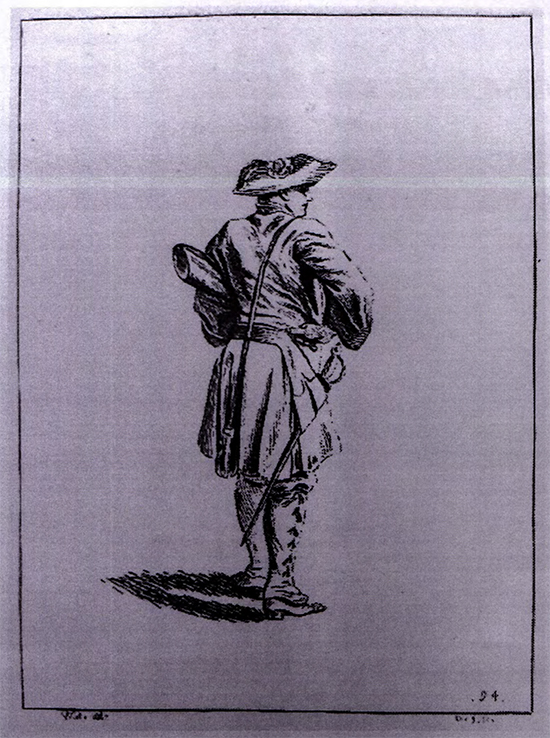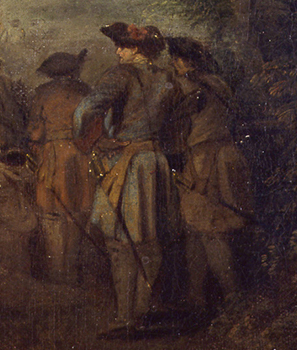
- Home Page
- Accepted
Paintings & Copies - Doubtful
Attributions - Doubtful Textual References
- Alternative
Titles - Collectors &
Museums - Bibliography
- Search Abecedario
- Watteau &
His Circle
Le Défilé
Entered March 2020; revised May 2020
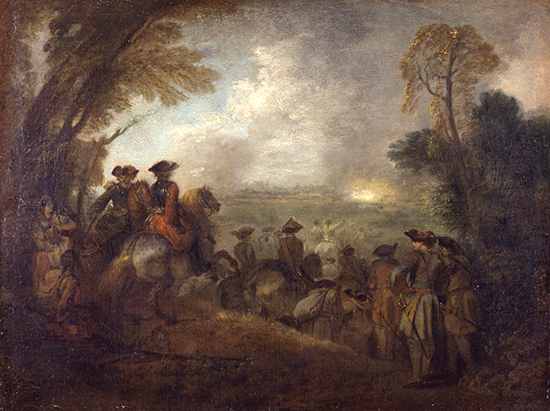
York, City of York Art Gallery
Oil on canvas
31.2 x 40 cm. (or 32.3 x 43.1 cm]
ALTERNATIVE TITLES
Un Défilé d’armée
Encampment
The Line of March
The March Past
A March of Cavalry
Une Marche de cavalarie et d’infanterie
RELATED PRINTS
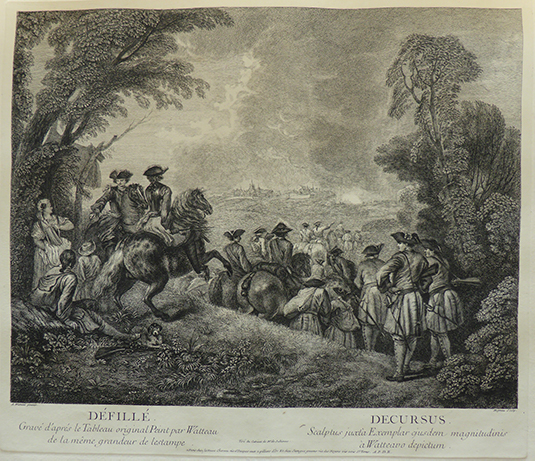
Jean Moyreau after Watteau, Le Defilé, engraving, c. 1730
Jean Moyreau engraved Le Defilé in the same sense as Watteau’s painting. The print was announced for sale in the April 1730 issue of Le Mercure de France (p. 207).
PROVENANCE
Paris, collection of Jean de Jullienne (1686-1766; director of a tapestry factory) together with pendant, L’Alte. The engraving states: “Tirée du Cabinet de Mr. de Jullienne.” We know that Jullienne sold the painting prior to 1756 because it was not included in the illustrated manuscript catalogue of his collection made at that time and now in the Morgan Library & Museum, New York.
Paris, collection of Louis François de Bourbon, prince de Conti (1717-1776). His sale, Paris, April 8–June 6, 1777, lot 665: “Antoine Watteau . . . Une Alte d'infanterie: on y voit trois femmes, dont une Vivandière. Une marche de Cavalerie & d'Infanterie. Ces deux tableaux qui sont d’un faire savant, sont peint sur toile, & portent chacun 13 pouces de haut, sur 16 pouces de large.” The painting sold for 665 livres to "Menajeau," according to an annotated copy of the catalogue in the Rijksbureau voor Kunsthistorische Documentatie.
Paris, collection of Augustin Ménageot (1700-1784; painter and dealer). His sale, Paris, March 17ff, 1778, lot 107: “ANTOINE WATTEAU . . . Des Marches de Soldats & Vivandiers; deux sujets faisant pendans d’une très-bonne couleur, & touchés avec beaucoup d’esprit. Larg. 16 pouces. Haut. 13. T.” The pair sold for 920 livres to Dubois, according to an annotated copy of the sale catalogue in the Frick Art Reference Library.
Paris, collection of M. Dubois (dealer in silverware and jewelry). His sale, Paris, March 31-April 5, 1784, lot 78: “A. WATTEAU . . . Deux Tableaux faisant pendans; l’un orné de vingt-figures, représente une halte de soldats; l’autre est un défilé d’armée, composition de vingt-trois figures. Ces deux Tableaux viennent de la Collection de M. le Prince de Conti. Haut. 12 pouces, largeur 15 pouces. Ils sont gravés par Moyreau.” The two pendants were supposedly sold for 723 livres to Grenier, according to the annotated copy of the catalogue in the Frick Art Reference Library, but this purported buyer was probably part of a fiction since the painting returned to Dubois and was put up at auction the following year.
Paris, sale, December 20ff, 1785, Dubois collection (presented anonymously), lot 79: “A. WATTEAU . . . Deux Tableaux faisant pendans, l’un orné de vingt figures, représente une halte de soldats; l’autre est un défilé d’armée, composition de vingt-trois figures. Ces deux Tableaux viennent de la collection de M. le Prince de Conty, & sont gravés par Moyreau. Hauteur 12 pouces, largeur 15 pouces.” Sold for 510 livres, according to an annotated copy of the sale catalogue in the Bibliothèque municipale, Versailles.
London, Christie’s, sale of the collection of General Sir John Murray and others, June 19, 1852, lot 18: “WATTEAU . . . A MARCH OF CAVALRY. A BESIEGED CITY IS SEEN IN THE DISTANCE, which is being bombarded. The engraving of this little picture will be found in the works of Watteau, in 2 vols., folio. It was formerly in the Collection of M. Julien." Sold for £32.11.0.
London, collection of Andrew James (1793-c.1857; London corn merchant); by descent to his widow, Ann (b. 1788); by descent to their daughter.
London, collection of Sarah Anne James (1829-c.1891).
London, collection of Ethel Mary Spiller (1859-1953; art teacher). Sold to Francis Dennis Lycett Green in 1927.
Goudhurst, Kent, collection of Francis Denis Lycett Green (1893–1959; industrialist). Given to the York Art Gallery in 1955.
EXHIBITIONS
London, Royal Academy, Old Masters (1891), cat. 47 (as by Watteau, Encampment, lent by Miss James).
York, City of York Art Gallery, Lycett Green Collection (1955), cat. 37 (as by Watteau, Le Défilé).
Montreal, Museum of Fine Arts, Héritage de France (1961), cat. 82 (by Watteau, Le Défilé, lent by the City Art Gallery, York).
London, Kenwood House, The French Taste in English Painting (1968), cat. 13 (as by Watteau, Le Défilé, lent by the York City Art Gallery).
Washington, Paris, Berlin, Watteau, 1684-1721 (1984), cat. 4 (as by Watteau, The Line of March [Défilé], lent by the York City Art Gallery).
Tokyo, Teien Museum, The Noble Horse (1998), cat. 8 (as by Watteau, The Line of March: ‘Le Défilé,’ lent by the York City Art Gallery).
SELECT BIBLIOGRAPHY
Hédouin, “Watteau” (1845), cat. 79.
Hédouin, Mosaïque (1856), cat. 80.
Goncourt, L’Art au XVIIIème siècle (1860), 56.
Goncourt, Catalogue raisonné (1875), cat. 58.
Mantz, Watteau (1892), 63-64.
Mantz, “Watteau”(1899), 188.
Dacier, Vuaflart, and Hérold, Jean de Jullienne et les graveurs (1921-29), cat. 223
Réau, “Watteau” (1928), cat. 44.
Adhémar, Watteau (1950), cat. 38.
Cailleux, “Four Studies of Soldiers” (1959), iv-vi.
Mathey, Watteau, peintures réapparues (1959), cat. 117, 67.
J.A.S.I, “Watteau: Le Défilé” (1960), 480-86.
York, City of York Art Gallery, Catalogue of Paintings (1961), cat. 792.
Brookner, Watteau (1967), pl. 7.
Macchia and Montagni, L’opera completa di Watteau (1968), cat. 41.
Ferré, Watteau (1972), cat. B5.
Banks, Watteau and the North (1977), 146-48.
Roland Michel, Watteau (1981), cat. 80.
Posner, Watteau (1984), 34, 279 n. 39.
Roland Michel, Watteau (1984), 167, 169, 273.
Munhall, “Portal of Valenciennes” (1992), 8.
Grasselli, “Eighteen Drawings by Watteau” (1993), 104.
Rosenberg and Prat, Watteau, catalogue raisonné des dessins (1996), 1: 60, 3: G12, G35, G45, G103, G116.
Vogtherr, Watteau at the Wallace Collection (2011), 34-37.
Glorieux, Watteau (2011), 78.
Wile, Watteau’s Soldiers (2016), 12, 92, 93, 95, 96.
RELATED DRAWINGS
None of the drawings that Watteau used for Le Défilé have survived, but some are recorded in the engravings of the Figures de différents caractères. The soldier seen from behind at the left side of the painting, one arm akimbo, the other holding a musket, was engraved by Boucher as plate 94 of the Figures de différents caractères.

Watteau, Le Défilé (detail).
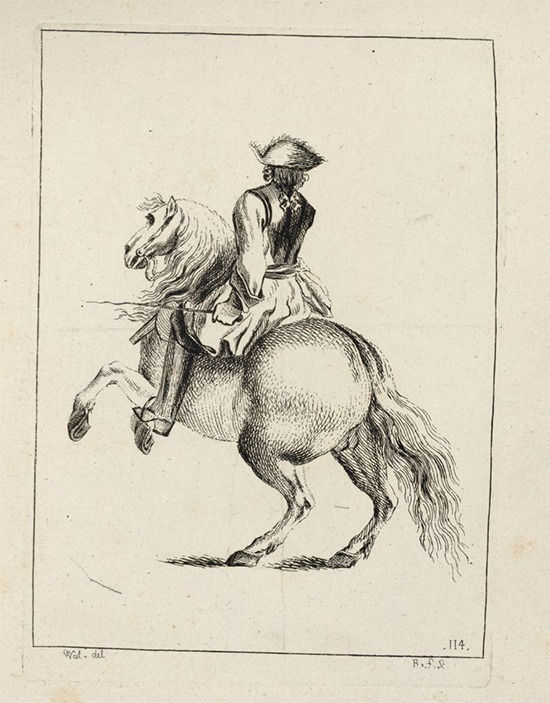
François Boucher after Watteau, Soldier seen from behind, seated on a rearing horse, engraving, Figures de différents caractères, plate 114.
The officer on a rearing horse, an unusually active figure for Watteau, was etched in reverse by François Boucher for the Figures de différents caractères, plate 114.
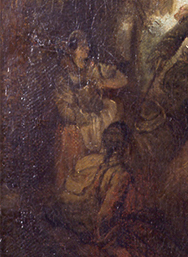
Watteau, Le Défilé (detail).
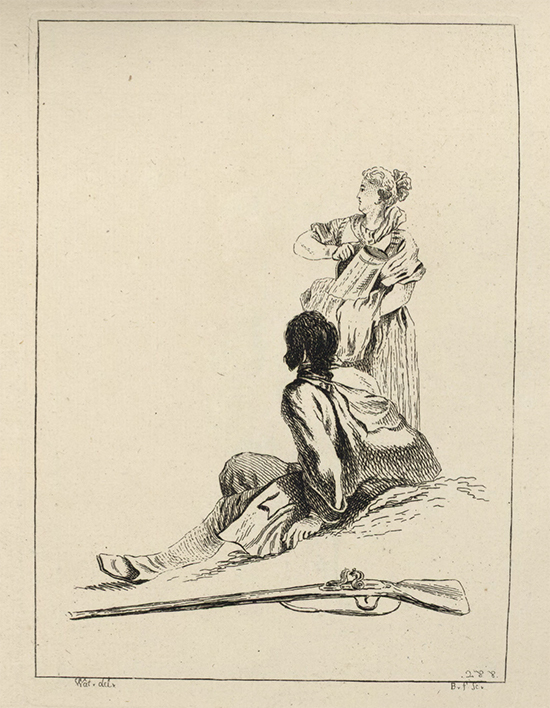
François Boucher after Watteau, A Woman with a Pitcher, and a Soldier Seated on the Ground, engraving, Figures de différents caractères, plate 288.
Perhaps the most problematic of Watteau’s studies for Le Défilé is the one recorded in plate 288 of the Figures de différents caractères. It corresponds to two figures in the left foreground of the painting: a standing woman with a pitcher or jug, and a soldier seated on the ground, his musket lying beside him. It is possible that this records a preliminary drawing that Watteau executed in his studio, yet he almost never posed two models together in the same relationship that they would have in the painting. Rosenberg and Prat proposed that Boucher copied this scene from the finished painting, a thesis that they also presented apropos of several similar plates in the Figures de différents caractères. However, there is no evidence that Jullienne’s engravers committed such deceptions. Another explanation is that Boucher copied an oil counterproof pulled from the canvas after the preliminary lines had been set down in brown paint and before the color was laid in. There are other instances in the Figures de différents caractères where Jullienne’s engravers copied such oil counterproofs, most notably plates 46 and 47, which are based on an oil counterproof made from L’Avanturière. Yet this explanation also is problematic, because plate 288 and the hypothetical counterproof would be in the same direction, whereas one should be in the opposite sense.
REMARKS
The history of Le Défilé in the eighteenth century is fairly continuous but not seamless. It traveled with its pendant, L’Alte, until the late part of the century and then it disappeared from sight. The York Gallery believes that their painting was in the Paris sale of the collection of Sir John Lambert on March 27, 1787, but the Watteau painting in that sale, lot 77, was the now-separated pendant. The whereabouts of Le Défilé cannot be documented again until the middle of the nineteenth century. We propose that it was the picture which came up at a Christie’s sale in 1852. The description of that painting, as being engraved, small in size, and showing a besieged city in the background fits Le Défilé. It was probably bought at that sale by Andrew James, who formed his collection from London sales. Although he died only a few years later, in 1857, it remained with his widow and then with his daughter Sarah. She is celebrated today as a distinguished collector of Watteau drawings, but it was actually her father who had built up the James collection. She lent the painting for exhibition in 1851, but Le Défilé otherwise went unobserved throughout the second half of the nineteenth century, and remained in obscurity well into the twentieth century. Neither Dacier, Vuaflart, and Hérold or Réau knew the painting’s whereabouts. Posner and Roland Michel in 1984 still described it as lost. Mathey knew that it had been in the Lycett Green collection but did not know its whereabouts in 1950. In short, it was not until the York City Art Gallery exhibited the Lycett Green collection in 1961 that scholars finally became acquainted with Watteau’s picture.
Only in the 1980s was it realized that the painting had been planned as an oval with the empty corner spaces overpainted to extend the picture to a rectangle. The oval format matches that of the original pendant, L’Alte, now in the Thyssen collection and offers additional proof of the authenticity of both works.
The dating of Le Défilé has generally centered on the premise that Watteau painted most of his military subjects around the time of his trip to Valenciennes. This trip was always presumed to have been undertaken in 1709, after Watteau failed to gain the Prix de Rome, but then in 2004 Hattori discovered that his trip occurred in late 1710. This should have implied that the military paintings were executed around 1711, yet this did not result in a redating of Le Défilé. Adhémar and Mathey, writing prior to 2004, favored a date of c.1709-10; Rosenberg proposed a still earlier date of c. 1706-07. But even those critics writing after 2004, such as Vogtherr and Glorieux, still retained a date of c. 1709.
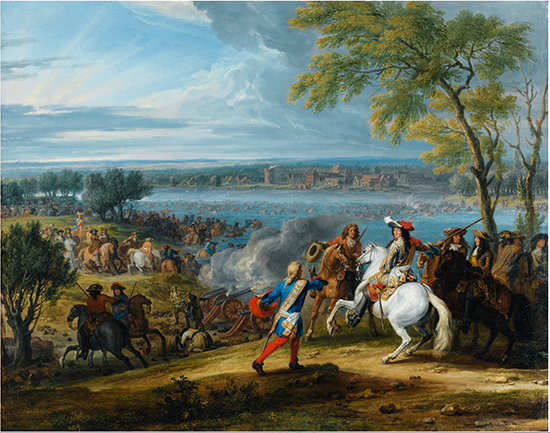
Adam Frans van der Meulen, Louis XIV Crossing the Rhine at Lobith, oil on canvas, 66 x 82 cm. Whereabouts unknown.

Watteau, Le Défilé.
It has become traditional to compare Watteau’s military subjects with paintings by Adam van der Meulen (1632-1690), the leading painter of such works under Louis XIV. Frequently Le Défilé has been juxtaposed with Van der Meulen’s Louis XIV Crossing the Rhine, a composition known not only through the large scale version now at Versailles but also through many studio replicas. Vogtherr opted for Van der Meulen’s Louis XIV at Besançon. It matters little which particular model is suggested since they all share the same basic composition: in the foreground a hill with equestrian officers, preferably one on a dramatically rearing horse; in the mid-ground massed soldiers moving off to the distance, and in the distance soldiers, small in scale, and in the air the smoke of battle rising. Le Défilé differs from most of Watteau’s military subjects, emphasizing the actual battle. Most of his other scenes focus on soldiers at rest or marching, but here the rearing horse and the columns of smoke reinforce the atmosphere of an actual military campaign. Even then Watteau cannot help adding softening touches, such as the woman in the left foreground who brings a jug of water to the soldiers recumbent on the ground.
Click here for copies of Le Defilé
